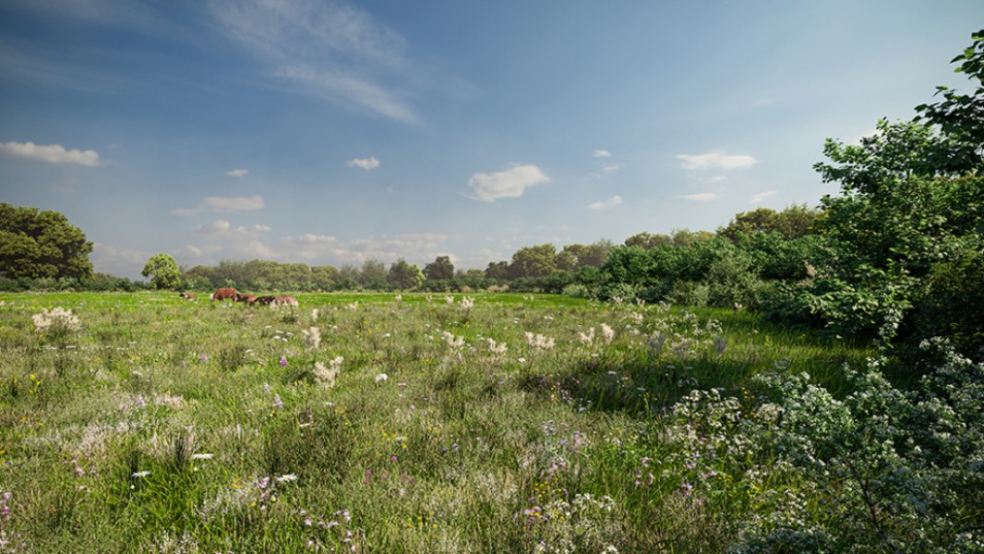
Environment Bank signs section 106 legal planning agreement on Puddington Habitat Bank
Environment Bank, the leading off-site Biodiversity Net Gain (BNG) provider, has announced that its Puddington Habitat Bank in Devon has entered into a section 106 (s106) agreement, ready to provide local off-site Biodiversity Units for the Mid Devon District.
s106 agreements are planning obligations with the local authority and, like in this case, can be used to bind the use of the land to biodiversity gains delivery for 30 years.
Under the Environment Act 2021, developers are required by law to ensure that all significant developments deliver a minimum 10% increase in biodiversity, and they can do so by purchasing Biodiversity Units from Habitat Banks created away from the development site, referred to as “off-site”.
The Puddington site is one of the first Habitat Banks in Devon and was visited recently by representatives from the Mid Devon District Council and Devon County Council. This was the councils’ first visit to a Habitat Bank where they discussed the site as a blueprint for new land management solutions and income diversification options for local farmers.
Puddington Habitat Bank covers 25 acres of marginal farmland on heavy clay. The work being done is focused on restoring the land to native species, rich grassland, woodland and scrub. The area is famous for its native breed of livestock, the Red Devon Cattle; livestock that the farmers who manage the Puddington Habitat Bank rear themselves. These cattle are being used to manage the recovering grasslands with sustainable grazing – mimicking the way that large wild roaming herbivores would naturally graze and manage the land historically.
The site sits at the top of the watershed of the Taw and the Exe (two significant Devon rivers), therefore directly impact the health and quality of local river water. If water falls on open soil, especially in clay areas such as this, the water collects the clay particles which quickly enter rivers creating sediment issues. The habitat restoration being done at the Puddington Habitat Bank is enabling the land to naturally clean and filter water and protect the soil from eroding by creating diverse grasslands with diverse root structures.
The landscape has long faced difficulty with intensive arable farming. The area has seen an increase of 15% in annual precipitation since the 1960s, making arable farming far more susceptible to run-off issues than before. Previously, with drier winters, operations were easier, but increasing wetness is making cultivation difficult and risking topsoil degradation and compaction. By switching to native cattle managing the ecosystem, their dung, trampling and grazing is stimulating the soil and encouraging wildflower populations to thrive.
Environment Bank has partnered with local farmers, Toby and Bella – leasing a parcel of their land to create the Puddington Habitat Bank and paying them an annual fee to help manage the habitats with cattle grazing. This is providing an additional income for Toby and Bella, restoring their land, and supporting their farming business model.
Mike Waller, Senior Ecologist at Environment Bank: “It is exciting that Puddington Habitat Bank is now to be secured under a s106. This means that there is a long term commitment to ensuring that biodiversity gains will be made, and this will have a transformative impact on the local area, rivers and native species. The effects of biodiversity and nature restoration have far reaching benefits, and this project serves as a great blueprint for other sites and farms in Devon and the wider regions.
What this demonstrates is that BNG not only contributes to national biodiversity objectives but also offers landowners a way to diversify their income streams, enhance their natural landscapes, and build business resilience for their farms.”
An Environment Bank BNG site in Yorkshire has also been secured under a s106 and 21 others have now been legally secured for BNG under conservation covenants with responsible body RSK Wilding. All these sites have been created and managed in partnership with rural landowners, and together cover well over 1,300 acres in total. These sites transform low-yielding farmland into nature recovery sites and maximise biodiversity uplifts, unlocking almost 2,000off-site Biodiversity Units for developers to purchase. Along with Puddington Habitat Bank, nineteen other Environment Bank sites from its large national network of over thirty BNG sites have been added to Natural England’s biodiversity gains site register, accounting for more than a third of the entire national registry
Toby Diggens & Bella Lowes, the local farmers partnering with Environment Bank, commented: “In the time since we began the restoration journey with Environment Bank, we have seen some amazing results. The grasslands are recovering, species such as snipe and woodcock, reed bunting and short eared owl have been seen using the landscape, and we have a useful late summer grazing parcel to keep our cows out for longer and drive down our farming overheads. In time, the Habitat Bank should develop into something super special, especially given that the area is famous for its Culm grassland and iconic species, such as the marsh fritillary butterfly, which we hope to see return one day.”











